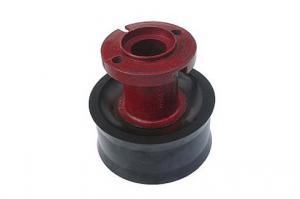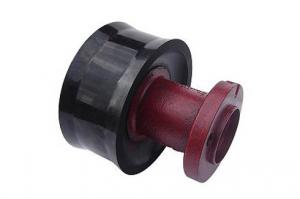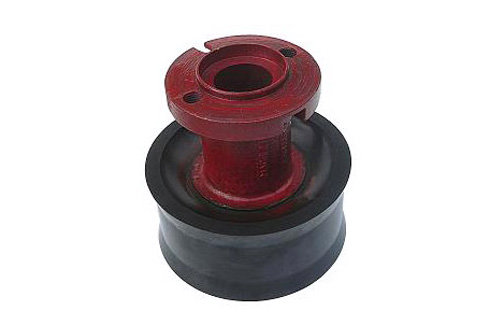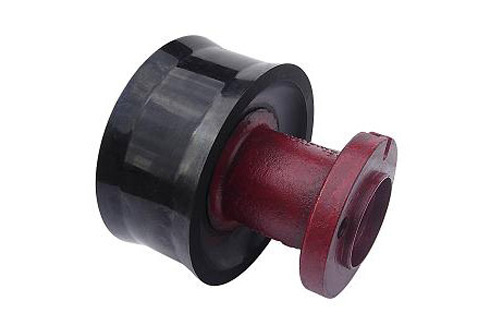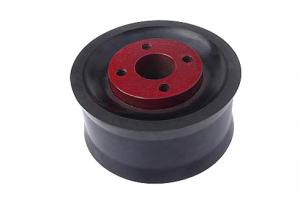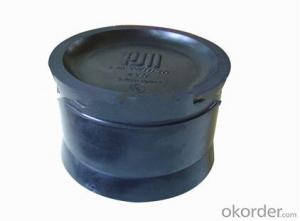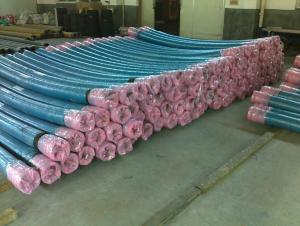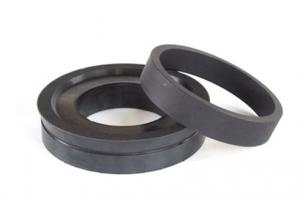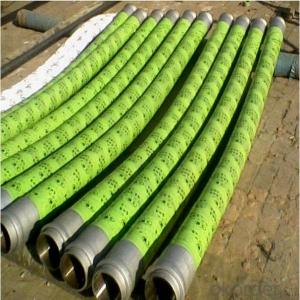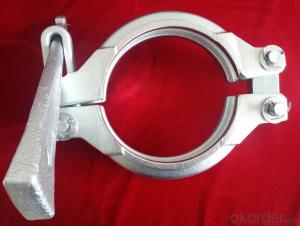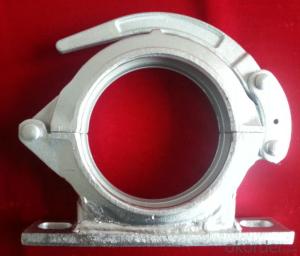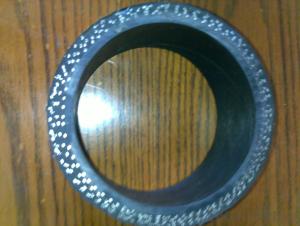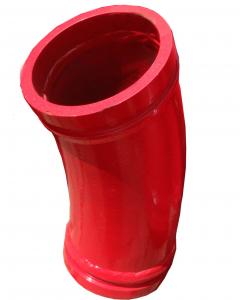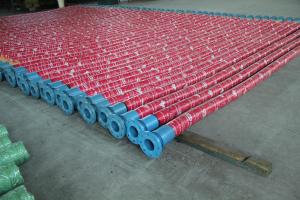Concrete Pump Rubber Ram Piston DN180 - DN250
- Loading Port:
- China Main Port
- Payment Terms:
- TT OR LC
- Min Order Qty:
- -
- Supply Capability:
- -
OKorder Service Pledge
Quality Product, Order Online Tracking, Timely Delivery
OKorder Financial Service
Credit Rating, Credit Services, Credit Purchasing
You Might Also Like
Brand: Schwing, Putzmeister, Sany,Zoomlion, IHI, Kyokuto, Sermac
Size: DN180 - DN250
Other products:
1) ST52 steel pipe, elbow, reducer
2) Wear-resisting board and Cuts ink
3) Coupling and seal ring for Putzmeister,Schwing, Sany
4) Rubber hose
5) Cleaning series and others
- Q: How often should concrete pump outriggers be inspected and maintained?
- To ensure the safe and efficient operation of concrete pump outriggers, it is important to regularly inspect and maintain them. It is recommended to perform inspections and maintenance before each use and at least once every six months. However, the frequency of inspections may vary depending on specific conditions and usage intensity. During regular inspections, it is necessary to check the outrigger pads, hydraulic cylinders, and other components for any signs of wear, damage, or leaks. Prompt repairs or replacements should be carried out as necessary to prevent further damage and ensure proper working condition of the outriggers. Furthermore, it is beneficial to properly lubricate moving parts and regularly clean the outriggers to extend their lifespan and maintain their performance.
- Q: How can one extend the lifespan of concrete pump spare parts?
- To extend the lifespan of concrete pump spare parts, there are several measures that can be taken: 1. Regular maintenance: It is crucial to perform regular maintenance on the concrete pump spare parts. This includes cleaning, lubricating, and inspecting the parts for any signs of wear or damage. By addressing any issues early on, you can prevent further damage and prolong the lifespan of the parts. 2. Proper storage: When not in use, it is important to store the spare parts in a clean and dry environment. Exposure to moisture, dust, and other contaminants can lead to corrosion and deterioration of the parts. Storing them in a designated area with appropriate protection can help prevent these issues. 3. Quality parts: Investing in high-quality spare parts can greatly influence their lifespan. Opting for reputable brands and manufacturers that produce durable and reliable parts can ensure their longevity. Although they may be more expensive initially, they will likely save you money in the long run as they will require less frequent replacement. 4. Proper usage: Following the manufacturer's guidelines and instructions for the concrete pump spare parts is crucial. Overloading or operating the equipment improperly can put excessive strain on the parts, leading to premature wear and tear. Using the parts within their recommended capacity and following proper operating procedures will help extend their lifespan. 5. Training and supervision: Ensuring that operators and maintenance personnel are properly trained and supervised can have a significant impact on the lifespan of concrete pump spare parts. Educating them on best practices, proper handling, and maintenance techniques will help prevent misuse or mishandling that can result in damage to the parts. 6. Regular inspections: Conducting regular inspections of the spare parts can help identify any potential issues early on. This can include checking for signs of wear, damage, or misalignment. By addressing these issues promptly, you can prevent further damage and extend the lifespan of the parts. By implementing these measures, you can significantly extend the lifespan of concrete pump spare parts, reducing downtime and improving efficiency in construction projects.
- Q: How do I identify the specific spare parts I need for my concrete pump?
- To find the specific spare parts you require for your concrete pump, you can follow these guidelines: 1. Refer to the user manual: Begin by consulting the user manual provided by the manufacturer. This manual typically includes a comprehensive list of parts, along with their respective numbers and descriptions. It may also feature diagrams or illustrations to aid in identifying the necessary spare parts. 2. Get in touch with the manufacturer: Reach out to the manufacturer of your concrete pump. They possess the most accurate and up-to-date information regarding spare parts for your particular model. Provide them with the model number and any other relevant details to ensure precise identification of the required parts. 3. Connect with authorized dealers or distributors: If the manufacturer cannot directly provide you with the spare parts, they can often direct you to authorized dealers or distributors. These professionals specialize in concrete pump parts and can assist you in identifying the specific spare parts you need. Share the model number and any other pertinent details to aid them in locating the correct parts. 4. Capture images or dimensions: If you are unable to find the necessary information through the manual, manufacturer, or authorized dealers, you can take pictures or measurements of the damaged or worn-out parts. This will help visually identify the parts and provide accurate dimensions, which can be shared with suppliers or industry experts who may be able to offer further assistance. 5. Conduct online research: Utilize online resources such as parts catalogs, forums, or websites dedicated to concrete pump spare parts. These platforms often have extensive databases and knowledgeable communities that can help you identify the specific spare parts you require. Search for your concrete pump model and explore the available resources to find the relevant parts. Remember to prioritize quality and authenticity when purchasing spare parts for your concrete pump. It is crucial to buy from reputable sources to ensure the durability and longevity of your equipment.
- Q: What are the fittings of concrete pump?
- The commonly used electrical accessories (button switch, switch, trip circuit breaker, transformer terminals, etc.), hydraulic pipe
- Q: What is the purpose of a concrete pump hopper grate?
- The purpose of a concrete pump hopper grate is to filter out any large debris or aggregates from the concrete mixture as it is being pumped into the hopper. It helps to ensure a smooth and consistent flow of concrete, preventing any blockages or clogs in the pump system.
- Q: How do I properly maintain and replace hydraulic motors in concrete pump spare parts?
- To ensure smooth operation and long-lasting performance of concrete pump spare parts, it is crucial to properly maintain and replace hydraulic motors. Here are some effective steps to guide you: 1. Regularly inspect the hydraulic motors to detect any signs of wear, damage, or leaks. Ensure the fluid levels are at the recommended levels. 2. Keep the hydraulic motors clean by removing dirt, debris, and contaminants. This prevents overheating and minimizes the risk of internal component damage. 3. Follow the manufacturer's recommendations and regularly check and change the hydraulic fluid. Clean and replace filters to prevent damage-causing particles. 4. Lubricate the hydraulic motors according to the manufacturer's instructions. This reduces friction and wear on moving parts, improving overall performance and lifespan. 5. Operate the concrete pump within the recommended load and pressure limits specified by the manufacturer. Excessive pressure or overloading can stress the hydraulic motors, leading to premature failure. 6. Keep track of the service life and usage of hydraulic motors. Over time, they may become less efficient. Promptly replace them to avoid disruptions to concrete pumping operations. 7. If unsure about maintenance or replacement, seek professional assistance. Professionals have the expertise to carry out tasks correctly, ensuring safety and optimal performance of concrete pump spare parts. By following these steps, you can effectively maintain and replace hydraulic motors in concrete pump spare parts, ensuring equipment longevity and efficiency.
- Q: How often should hopper grate levers be inspected or replaced in a concrete pump?
- To ensure the proper functioning and prevent potential issues, it is necessary to regularly inspect the hopper grate levers in a concrete pump. The frequency of inspections may vary based on factors such as usage intensity, material being pumped, and operating conditions. However, a general recommendation is to conduct inspections at least once every six months or after every 500 hours of operation. During the inspection, carefully examine the hopper grate levers for signs of wear, damage, or misalignment. If any issues are identified, it is crucial to promptly replace the levers to prevent further damage to the hopper grate system or potential safety hazards. To ensure optimal performance and durability, it is essential to utilize high-quality replacement parts specifically designed for the concrete pump model. By conducting regular inspections and timely replacements of hopper grate levers, the efficiency and reliability of the concrete pump can be maintained, minimizing downtime and expensive repairs.
- Q: How is a concrete pump pipe different from a regular pipe?
- A concrete pump pipe has been specifically designed to transfer high-pressure concrete mixtures from a concrete pump truck to a desired location. Unlike a standard pipe, it is constructed using durable materials such as hardened steel or alloy, which can withstand the intense pressures and abrasion caused by the concrete mixture. One significant contrast between a concrete pump pipe and a regular pipe lies in the thickness of their walls. Concrete pump pipes possess thicker walls to ensure they can withstand the high pressure and abrasive nature of the concrete mixture. Conversely, regular pipes are designed for various purposes such as water or gas transportation and may not have the same level of thickness and durability. Furthermore, concrete pump pipes are often equipped with different end connections, such as flanges or couplings, to facilitate easy attachment and detachment from the concrete pump truck and other pipeline components. This ensures a secure and leak-free transfer of the concrete mixture. Additionally, concrete pump pipes may feature special design elements to enhance their performance and longevity. These elements may include wear-resistant linings, heat treatment, or galvanization to prevent corrosion and extend the pipe's lifespan. To summarize, a concrete pump pipe exhibits variations from a regular pipe in terms of its materials, thickness, end connections, and design features. These distinctions enable concrete pump pipes to efficiently and effectively handle the unique demands of pumping high-pressure concrete mixtures.
- Q: How often should concrete pump electric motors be inspected and maintained?
- To ensure the optimal performance and longevity of concrete pump electric motors, it is crucial to regularly inspect and maintain them. It is advisable to have them checked at least once a year or after every 500-1000 operating hours, depending on which comes first. Furthermore, it is important to follow the manufacturer's guidelines and recommendations for regular maintenance. This may involve examining electrical connections for signs of damage or loose connections, cleaning dust and debris, lubricating moving components, and replacing worn-out parts. By adhering to a consistent inspection and maintenance schedule, one can avoid potential breakdowns, extend the motor's lifespan, and ensure efficient operation of the concrete pump.
- Q: What is the role of a concrete pump hopper agitator shaft?
- The role of a concrete pump hopper agitator shaft is to ensure the consistent and uniform mixing of concrete within the hopper. It rotates to prevent the concrete from settling or becoming compacted, ensuring a smooth and continuous flow of concrete through the pump, ultimately improving the efficiency and effectiveness of the pumping process.
Send your message to us
Concrete Pump Rubber Ram Piston DN180 - DN250
- Loading Port:
- China Main Port
- Payment Terms:
- TT OR LC
- Min Order Qty:
- -
- Supply Capability:
- -
OKorder Service Pledge
Quality Product, Order Online Tracking, Timely Delivery
OKorder Financial Service
Credit Rating, Credit Services, Credit Purchasing
Similar products
Hot products
Hot Searches
Related keywords
